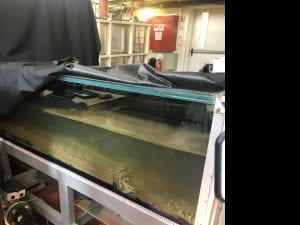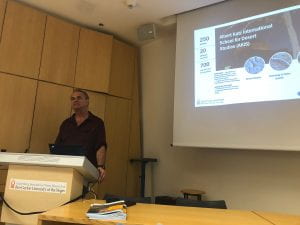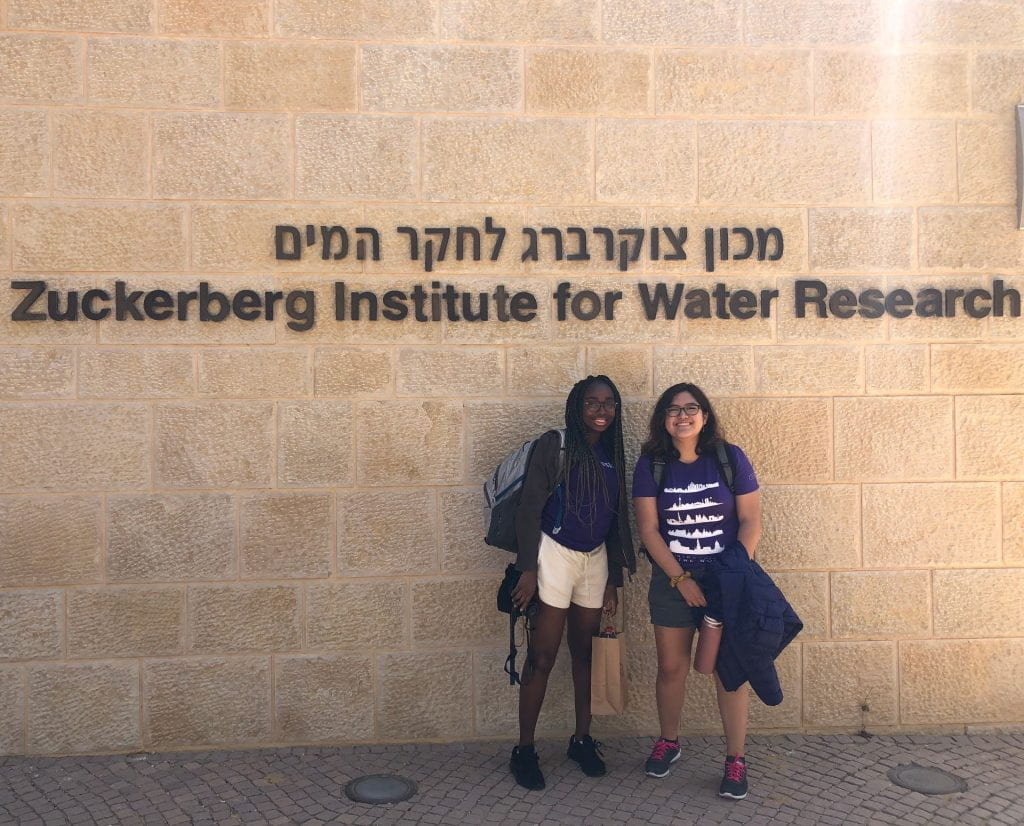Continuing to Make the Desert Bloom
by Valeria Apolinario and Carmen Awin-Ongya
The first visit in our GET Trek to Israel was to the Zuckerberg Institute for Water Research, one of the three institutes part of the Jacob Blaustein Institutes for Desert Research at Ben Gurion University. The visit was in the southern desert region of Israel known as the Negev. We traveled there from our hotel in Be’er Sheva, taking notice of the beautiful scenery as we made our way across the desert.
When we entered the fairly modern facility, we encountered a gorgeous cat, the first of many. We were ushered into an instruction room and provided Israeli cookies and coffee from a machine that would randomly go off throughout the afternoon. Our first guest speaker was the director of the Jacob Blaustein Institutes, Noam Weisbrod. He spoke about the institute’s dedication to findings solutions and better understanding the challenges of the Negev, which could be applied internationally.
Our next speaker was Shai Arnon, whose research focuses on water quality of streams, stream restoration, contaminant transport, and micro-plastics in the streams. When we asked him about the research process, he spoke about two paths: one being that the science the research is focused on will get published and could have practical use after 10 to 20 years or that research can work with industry to come up with practical applications. He gave us an example of the implementation of an online water quality monitoring system in a stream that allows for early detection of low water quality to warn those doing activities downstream, such as kayakers. This occurred using the research that he had done in previous years. He then took us to his lab and we saw the modeling systems that he uses to create conditions in streams to mimic those in nature.

One of Shai Arnon’s, Senior Lecturer, research modeling stations at the Zuckerberg Institute for Water Research.
After a quick break, we were introduced to Edo Bar-Zeev. His research is on applied environmental biology with a focus on biofilms and viruses. He gave us an anecdote about an injured motorcyclist who had an infection in his leg. The motorcyclist had two choices, to either amputate his leg or undergo a lesser-known treatment, phage therapy. He chose the latter and saved his leg. Dr. Bar-Zeev researches the mechanical aspect of a phage attacking a bacterium. He uses nanoscale resolution of images done in vitro and measures the force applied by the imaging needle, which we were luckily able to see when we visited his lab. When asked about the application of his research, he stated that it was for the understanding of fundamental science and that if it would be applied, it would be in the medical field as it would be nearly impossible to apply it to biofilms in wastewater management.
We then met Naftali Lazarovitch, who is from the French Associates Institute for Agriculture and Biotechnology of Drylands. His research focus is on water flow and solute transport in the soil-plant-atmosphere continuum to increase agricultural productivity and maintain environmental sustainability. He works with sensors and numerical models to create visual models of the effects of water flow and solute transport to better understand the constraints on plants for desert farming. However, the most important lesson that he taught us was at the beginning of his lecture where he shared his personal story of perseverance and stated that “you can start almost with nothing and in the end, you can be a professor.”
Our final speaker, Jack Gilron, briefly spoke about his research in applying desalinated water for agriculture, with a focus on electrodialysis membranes that can retain calcium and magnesium ions which would be better for crops. He then took us to the Zuckerberg Pilot Plant for Desalination and Water Treatment, where he showed us a spiral membrane commonly used at desalination plants in Israel. Next to this was a system using a specific spiral membrane that reduces nitrates in water; this system will eventually be scaled up and deployed in Ghana and India.
Overall, we had an amazing time getting to know the Zuckerberg institute and our five speakers. This experience has opened our minds to the research being done in the Negev, realizing that the desert, as well as scientific ingenuity, continues to bloom there.


